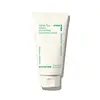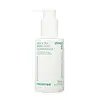What's inside
What's inside
 Key Ingredients
Key Ingredients

 Benefits
Benefits

 Concerns
Concerns

 Ingredients Side-by-side
Ingredients Side-by-side

Water
Skin ConditioningGlycerin
HumectantMyristic Acid
CleansingLauric Acid
CleansingPotassium Hydroxide
BufferingStearic Acid
CleansingGlyceryl Stearate
EmollientGlycol Distearate
EmollientPalmitic Acid
EmollientLauryl Hydroxysultaine
CleansingPolyquaternium-22
Lauryl Glucoside
CleansingPropanediol
SolventParfum
MaskingPotassium Cocoyl Glycinate
1,2-Hexanediol
Skin ConditioningHydrolyzed Corn Starch
HumectantPinus Densiflora Leaf Extract
AntimicrobialDisodium EDTA
Butylene Glycol
HumectantArginine
MaskingAspartic Acid
MaskingGlutamic Acid
HumectantEthylhexylglycerin
Skin ConditioningCamellia Sinensis Leaf Extract
AntimicrobialAcrylates/Stearyl Methacrylate Copolymer
Emulsion StabilisingTremella Fuciformis Sporocarp Extract
AntioxidantTetrasodium EDTA
Hyaluronic Acid
HumectantXanthan Gum
EmulsifyingCeramide NP
Skin ConditioningAcorus Calamus Root Extract
PerfumingWater, Glycerin, Myristic Acid, Lauric Acid, Potassium Hydroxide, Stearic Acid, Glyceryl Stearate, Glycol Distearate, Palmitic Acid, Lauryl Hydroxysultaine, Polyquaternium-22, Lauryl Glucoside, Propanediol, Parfum, Potassium Cocoyl Glycinate, 1,2-Hexanediol, Hydrolyzed Corn Starch, Pinus Densiflora Leaf Extract, Disodium EDTA, Butylene Glycol, Arginine, Aspartic Acid, Glutamic Acid, Ethylhexylglycerin, Camellia Sinensis Leaf Extract, Acrylates/Stearyl Methacrylate Copolymer, Tremella Fuciformis Sporocarp Extract, Tetrasodium EDTA, Hyaluronic Acid, Xanthan Gum, Ceramide NP, Acorus Calamus Root Extract
Cetyl Ethylhexanoate
EmollientIsopropyl Palmitate
EmollientSorbeth-30 Tetraoleate
EmulsifyingCaprylic/Capric Triglyceride
MaskingDecyl Cocoate
EmollientC9-12 Alkane
SolventDiisostearyl Malate
EmollientParfum
MaskingCoco-Caprylate/Caprate
EmollientPrunus Armeniaca Kernel Oil
MaskingSimmondsia Chinensis Seed Oil
EmollientOryza Sativa Bran Oil
EmollientCamellia Sinensis Seed Oil
HumectantPrunus Amygdalus Dulcis Oil
Skin ConditioningWater
Skin ConditioningArginine
MaskingButylene Glycol
HumectantPropanediol
Solvent1,2-Hexanediol
Skin ConditioningAcorus Calamus Root Extract
PerfumingEthylhexylglycerin
Skin ConditioningSodium Metaphosphate
BufferingCamellia Sinensis Leaf Extract
AntimicrobialCetyl Ethylhexanoate, Isopropyl Palmitate, Sorbeth-30 Tetraoleate, Caprylic/Capric Triglyceride, Decyl Cocoate, C9-12 Alkane, Diisostearyl Malate, Parfum, Coco-Caprylate/Caprate, Prunus Armeniaca Kernel Oil, Simmondsia Chinensis Seed Oil, Oryza Sativa Bran Oil, Camellia Sinensis Seed Oil, Prunus Amygdalus Dulcis Oil, Water, Arginine, Butylene Glycol, Propanediol, 1,2-Hexanediol, Acorus Calamus Root Extract, Ethylhexylglycerin, Sodium Metaphosphate, Camellia Sinensis Leaf Extract
 Reviews
Reviews

Ingredients Explained
These ingredients are found in both products.
Ingredients higher up in an ingredient list are typically present in a larger amount.
1,2-Hexanediol is a synthetic liquid and another multi-functional powerhouse.
It is a:
- Humectant, drawing moisture into the skin
- Emollient, helping to soften skin
- Solvent, dispersing and stabilizing formulas
- Preservative booster, enhancing the antimicrobial activity of other preservatives
Acorus Calamus Root Extract is a fragrance.
Arginine is an amino acid that is important for human development. Your body uses is it to produce hair keratin and skin collagen.
As a cosmetic ingredient, Arginine has antioxidant properties and can also help repair damaged skin. This ingredient is derived either synthetically or from animals.
Arginine isn't fungal acne safe when used in the presence of other lipids (fats, fatty acids, oils, esters, etc). Oils and fats occur naturally within the skin, so take caution when using Arginine if you're prone to fungal acne.
Learn more about ArginineButylene Glycol (or BG) is used within cosmetic products for a few different reasons:
Overall, Butylene Glycol is a safe and well-rounded ingredient that works well with other ingredients.
Though this ingredient works well with most skin types, some people with sensitive skin may experience a reaction such as allergic rashes, closed comedones, or itchiness.
Learn more about Butylene GlycolCamellia Sinensis Leaf Extract is derived from the leaves of the tea plant. Black tea, green tea, and oolong tea are all harvested from this plant.
This ingredient has many skin benefits:
This ingredient contains polyphenols, a strong antioxidant. Antioxidants help fight off molecules that damage skin cells.
On top of that, the antioxidants in green tea neutralize free-radicals from the sun. This gives the skin some extra UV protection, but should not replace sunscreen.
Many components of tea have anti-inflammatory properties.
Polyphenols and L-theanine help soothe the skin and reduce irritation. The caffeine in Camellia Sinensis Leaf Extract helps calm inflamed blood vessels.
Other compounds found in tea include: Vitamin Bs, linoleic acid, magnesium, calcium, iron, and zinc.
Research has shown both drinking Camellia Sinensis Leaf Tea and applying it to the skin can help boost skin elasticity and hydration. Studies also show using tea extract may reduce sebum, or oil, production.
Learn more about Camellia Sinensis Leaf ExtractEthylhexylglycerin (we can't pronounce this either) is commonly used as a preservative and skin softener. It is derived from glyceryl.
You might see Ethylhexylglycerin often paired with other preservatives such as phenoxyethanol. Ethylhexylglycerin has been found to increase the effectiveness of these other preservatives.
Parfum is a catch-all term for an ingredient or more that is used to give a scent to products.
Also called "fragrance", this ingredient can be a blend of hundreds of chemicals or plant oils. This means every product with "fragrance" or "parfum" in the ingredients list is a different mixture.
For instance, Habanolide is a proprietary trade name for a specific aroma chemical. When used as a fragrance ingredient in cosmetics, most aroma chemicals fall under the broad labeling category of “FRAGRANCE” or “PARFUM” according to EU and US regulations.
The term 'parfum' or 'fragrance' is not regulated in many countries. In many cases, it is up to the brand to define this term.
For instance, many brands choose to label themselves as "fragrance-free" because they are not using synthetic fragrances. However, their products may still contain ingredients such as essential oils that are considered a fragrance by INCI standards.
One example is Calendula flower extract. Calendula is an essential oil that still imparts a scent or 'fragrance'.
Depending on the blend, the ingredients in the mixture can cause allergies and sensitivities on the skin. Some ingredients that are known EU allergens include linalool and citronellol.
Parfum can also be used to mask or cover an unpleasant scent.
The bottom line is: not all fragrances/parfum/ingredients are created equally. If you are worried about fragrances, we recommend taking a closer look at an ingredient. And of course, we always recommend speaking with a professional.
Learn more about ParfumPropanediol is an all-star ingredient. It softens, hydrates, and smooths the skin.
It’s often used to:
Propanediol is not likely to cause sensitivity and considered safe to use. It is derived from corn or petroleum with a clear color and no scent.
Learn more about PropanediolWater. It's the most common cosmetic ingredient of all. You'll usually see it at the top of ingredient lists, meaning that it makes up the largest part of the product.
So why is it so popular? Water most often acts as a solvent - this means that it helps dissolve other ingredients into the formulation.
You'll also recognize water as that liquid we all need to stay alive. If you see this, drink a glass of water. Stay hydrated!
Learn more about Water